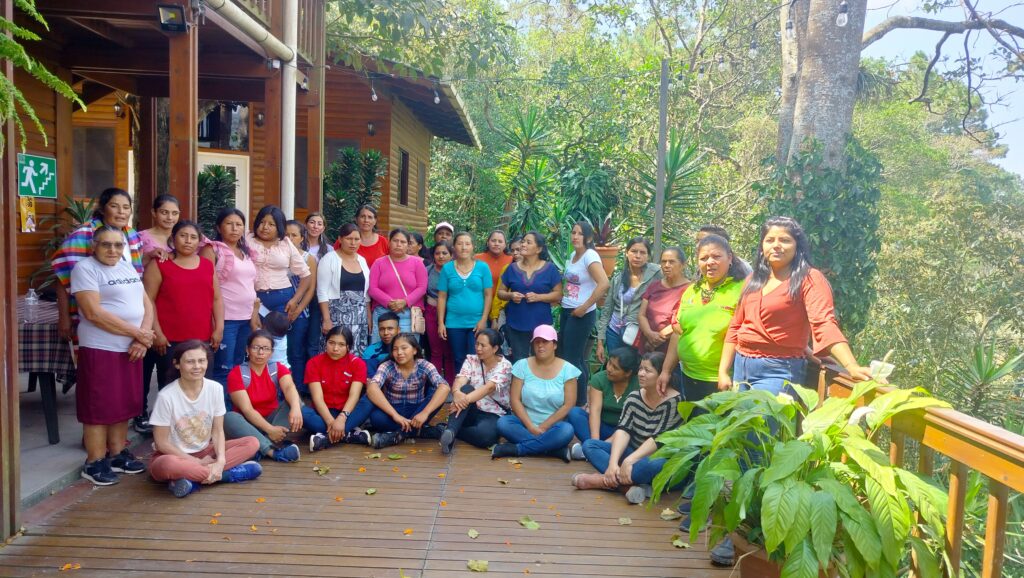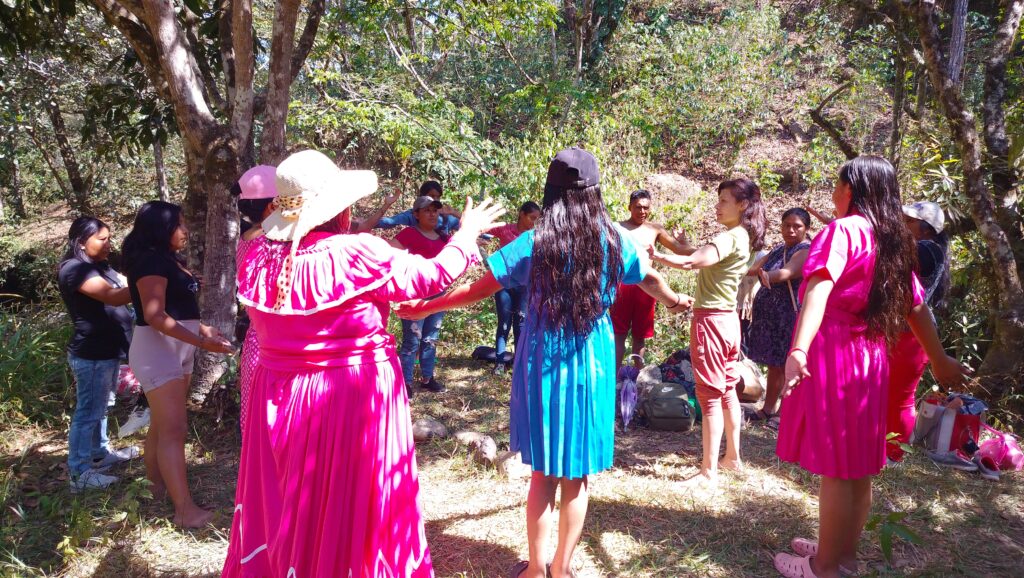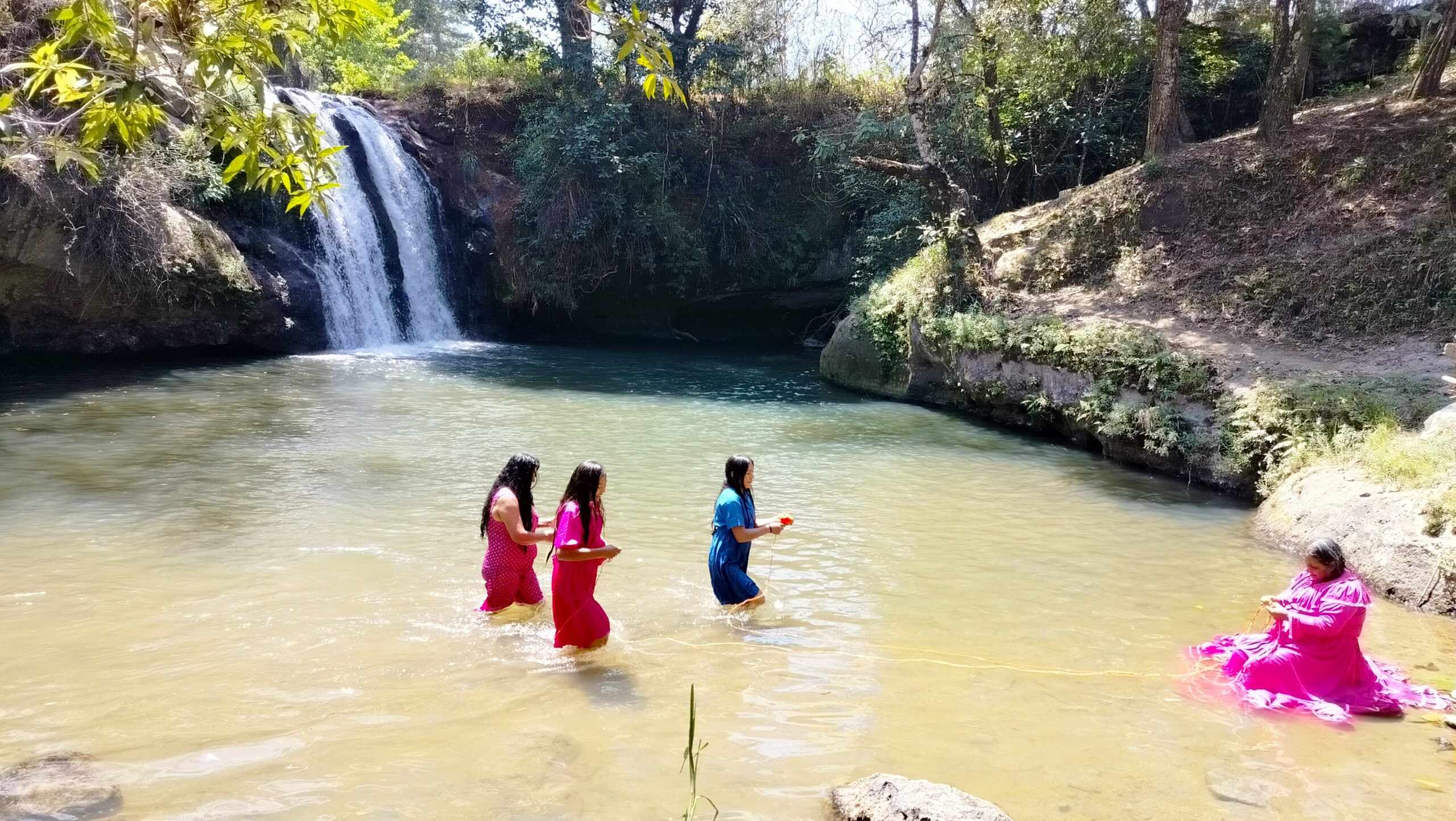Photo by Isadora Paz-Taboada
[ID: On a sunny day, four women explore their relationship with water and ropes. One is sitting on a rock and holding the end of the ropes while the other women are standing in the water. They are wearing typical dresses from Lenca culture.]
This article was written in English and Spanish. For the Spanish version, please click here.
Este artículo fue escrito en inglés y español. Para la versión en español, haga clic aquí.
*Wise woman. In Spanish Savia means Sap, and Sabia means to be wise, we want to emphasize the meaning and relation between both words.
**Lenka cacaopera language
What am I?
It’s the memory of the space that existed, inside and outside of me.
What is that space?
It’s my grandmother’s house, the yuyuba tree in the garden, the layer of cells that originated my heart, my grandmother’s chest that cradled me as a child, or my own chest.
The memory of the space moves me, as if it were a consequence of my desire to inhabit that space again, to expand there, to explore every fold, every corner, and every texture.
Who we are is essentially linked to the space in which we grew up and all the memories we have about those spaces. When we talk about the space where we grew up, we include the space of the maternal womb, the spatial configuration of embryological development, the coordinated and precise movement of cells that originates human tissues and systems.
Thus, as Honduran artists we decided to undertake the task to explore the geographical spaces inhabited by our indigenous Lenca ancestors. The Lencas are a Mesoamerican group that occupies part of the territory of Honduras and El Salvador. Currently, there are around half a million Lencas who preserve their culture, gastronomy, clothing, agriculture, dances, and rituals. The Lenca indigenous movement is now internationally recognized for their struggles in defense of rivers and forests.

[ID: Group of Lenca women who participated in the movement and ritual exchange workshop. They sit and stand together on a large balcony on a sunny day.]
In March 2024, we held a movement exchange meeting with indigenous Lenca women in the department of La Paz, Honduras. Environmental leaders, farm workers and artisan women from eight communities in the area gathered to exchange movement, dance, and rituals linked to nature and indigenous culture. This exchange is part of a collaborative and multidisciplinary performance led by three Honduran artists: Diana Lara, Isadora Paz Taboada (movement artists), and Gabriel Vallecillo-Marquez (video artist). The project is being developed in Honduras and San Francisco and is part of the Edge residency at CounterPulse, which will premiere in June 2024.
We were fortunate to work in collaboration with the organization Murilpaz, Indigenous Lenca Women Association from La Paz. On the first day of the meeting, the participants opened the event by performing the “compostura.” The compostura is one of the original ceremonies that are configured as a dance-rite and tribute to Mother Earth. For centuries, the Lenca people have interpreted this ceremony to mark the moments of the planting and harvesting cycle. In the representation, the participants set up an altar and recreate a series of acts and consecration movements for abundance, anticipating the arrival of the rainy season. The ritual, as interpreted through the lens of the Murilpaz organization, expands much more, as its leader Donatila shares, “We ask that the land be distributed equitably, we ask that the lands belong to women.”

[ID: Group of women and youth, some women are wearing dresses with bright colors that are part of Lenca culture. They have their arms open and they are doing a somatic exploration guided by Diana Lara.]
Each woman brought an element that is part of the altar, such as copal, colored candles, vegetables, fruits, and flowers. The candles were placed marking the cardinal points: white towards the north, which signifies purity; yellow towards the south, which signifies fertility, seed, and reproduction of women and nature; red towards the east, which signifies the blood of martyrs, the people who have resisted and been killed; and black or purple towards the west, which represents the ancestors, those who have already departed. In the center of the compostura, a green candle representing nature and a blue one representing the sky were placed.
The first day of the workshop coincided with the celebration of International Women’s Day, March 8th. In Honduras, there is a tradition of celebrating Women’s Day with events in communities at the local and national levels. It was then very significant that this exchange of body awareness, somatic movement, and rituals in nature took place specifically on this date.
On the second day of the meeting, we continued our exploration of movement and rituals at a specific site chosen by Murilpaz to allow contact with nature. “The island” is located an hour from Marcala by unpaved road. It is a small area of land through which a river passes, forming a water pool and a waterfall. In this place, we remembered the movements generated the previous day in this new landscape, incorporating the element of water and the guacales. Guacales are oval-shaped vessels of pre-Columbian origin made from a tree called jicara. They are used in Honduras to carry water and for other uses in cooking and daily activities.
Another element we explored both days was the use of the Lenca language. Currently, there is a process of recovery and revitalization of the Lenca language, which ceased to be spoken in the mid-20th century. The young women who attended the workshop are learning in school to speak and write one of the Lenca languages. We encouraged the participants to write a sentence related to Lenca culture in Spanish and Lenca and to incorporate movement into the sentence. The process was creative and playful and opened the door to collaboration among women from different generations.
The scenarios of the body and the expression of dance are rooted in territories, collective memory, the exchange between tradition and modernity, between multiple identities. Dance continues to occur in squares, in the scenarios of the everyday, and also in dance halls and theaters. Our task as Honduran performing artists is to reinterpret this wealth of movements, sounds, rituals, emotions, and language that are alive in our Lenca culture and roots. We want to share this performance with others to motivate them to explore all their roots and especially those that are less visible. It is not an easy task but it is worth the challenge.
Visit counterpulse.org/edge2024/ for tickets and information about Savia~SapFlow, made possible with generous support from CounterPulse Edge Residency and German Cultural Center in Honduras.
This article appeared in the Spring 2024 issue of In Dance.
Diana Lara is a choreographer, performer, and somatic movement educator born and raised in Honduras. Her choreographic work is influenced by contemporary dance, contact improvisation, Body-Mind Centering training, and Latinx culture. She creates choreographies that explore the effects of coloniality, religion, and gender on the body, and that generate rituals to peel layers of oppression. Her choreography has been staged in San Francisco Bay Area venues including the Mission Cultural Center for Latino Arts, NohSpace, Dance Mission Theater, among others. http://www.dianalara-somatics.com/
Isadora Paz Taboada is a Honduran-Argentinian choreographer and performer, co-founder of DA escenica, an independent collaborative project based in Tegucigalpa, Honduras. She has been a resident artist at ADF Durham, NC and the National Choreographic Center in La Rochelle, France. She explores community narratives, practices and performances promoting collective inquiry and intercultural dialogue through dance and performance. DA escenica


